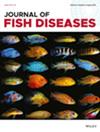万年青中的丝氨酸蛋白酶抑制剂 3(Serpin3)选择性地与副溶血性弧菌 PirAvp 相互作用
IF 2.2
3区 农林科学
Q2 FISHERIES
引用次数: 0
摘要
急性肝胰腺坏死病(AHPND)是对虾养殖领域的一项重大挑战。这种疾病主要由携带编码 PirAvp 和 PirBvp 毒素的 pVA1 质粒的副溶血性弧菌菌株引起。要防治这种流行病并减轻其破坏性后果,关键是要确定与这些致病毒素结合的受体并确定其特征。我们的研究发现,从对虾肝胰腺组织中提取的万年青丝氨酸蛋白酶抑制剂3(PvSerpin3)能与重组PirAvp结合,证实了其作为新型PirAvp结合蛋白(PABP)的作用。通过综合计算方法,我们发现了两个由PvSerpin3衍生的截短的PirAvp结合蛋白,分别称为Serpin3(13)和Serpin3(22),它们与PirAvp的亲和力高于全长的PvSerpin3。PABP 基因从从虾提取的总 RNA 逆转录的 cDNA 文库中扩增,克隆并在大肠杆菌中表达。对三个 PABP 包涵体进行重折叠以获得可溶性形式,发现 Serpin3 和 Serpin3(13) 的回收率为 100%,而 Serpin3(22) 的回收率仅为 50%。共免疫沉淀(co-IIP)和点印迹检测证实了这些重组 PABPs 与重组 PirAvp 和 VPAHPND (XN89) 产生的天然毒素之间的相互作用。本文章由计算机程序翻译,如有差异,请以英文原文为准。
Serine protease inhibitor 3 (Serpin3) from Penaeus vannamei selectively interacts with Vibrio parahaemolyticus PirAvp
Acute Hepatopancreatic Necrosis Disease (AHPND) represents a significant challenge in the field of shrimp aquaculture. This disease is primarily caused by Vibrio parahaemolyticus strains harbouring the pVA1 plasmid encoding the PirAvp and PirBvp toxins. To combat this epidemic and mitigate its devastating consequences, it is crucial to identify and characterize the receptors responsible for the binding of these pathogenic toxins. Our studied discovered that Penaeus vannamei's Serine protease inhibitor 3 (PvSerpin3) derived from shrimp hepatopancreatic tissues could bind to recombinant PirAvp, confirming its role as a novel PirAvp-binding protein (PABP). Through comprehensive computational methods, we revealed two truncated PirAvp–binding proteins derived from PvSerpin3 called Serpin3(13) and Serpin3(22), which had higher affinity to PirAvp than the full-length PvSerpin3. The PABP genes were amplified from a cDNA library that was reversed from total RNA extracted from shrimp, cloned and expressed in Escherichia coli. Three PABP inclusion bodies were refolded to obtain the soluble form, and the recovery efficacy was found to be 100% for Serpin3 and Serpin3(13), while Serpin3(22) had a recovery efficacy of roundly 50%. Co-Immunoprecipitation (co-IP) and dot blot assays substantiated the interaction of these recombinant PABPs with both recombinant PirAvp and VPAHPND (XN89)-producing natural toxins.
求助全文
通过发布文献求助,成功后即可免费获取论文全文。
去求助
来源期刊

Journal of fish diseases
农林科学-海洋与淡水生物学
CiteScore
4.60
自引率
12.00%
发文量
170
审稿时长
6 months
期刊介绍:
Journal of Fish Diseases enjoys an international reputation as the medium for the exchange of information on original research into all aspects of disease in both wild and cultured fish and shellfish. Areas of interest regularly covered by the journal include:
-host-pathogen relationships-
studies of fish pathogens-
pathophysiology-
diagnostic methods-
therapy-
epidemiology-
descriptions of new diseases
 求助内容:
求助内容: 应助结果提醒方式:
应助结果提醒方式:


